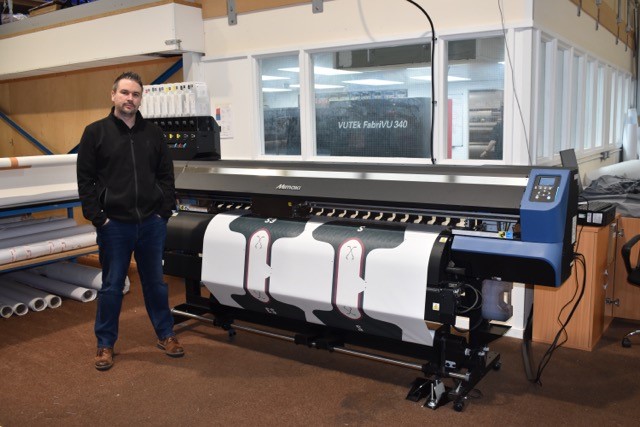Up and down the country printers are eyeing up the opportunities that textile printing presents. Soft signage has long been a standard offering, but décor and direct-to-garment printing are both forcing their way further and further into the mainstream and, for a relatively small investment, there are plenty of other possibilities in this sector. Charlie Kortens explored
Soft signage can be considered a sort of ‘gateway drug’ into textile printing. Companies invest in a wide-format dye sublimation printer in order to produce banners, hoardings or flags, and then realise how easily they can offer a whole host of other services.
Something along these lines happened at Banner Box, a Chesterfield-based business which has been involved in wide-format printing for over 20 years. The company produces a range of outdoor and indoor display products on four Mimaki printers, including a TS55-1800 that was only installed this year, as well as an EFI FabriVu 340.
The most recent Mimaki unit, which prints at 135sqm/hr and can handle light black and fluorescent inks, was purchased to help the company meet its soft signage needs, but also to print sportswear, a sector Banner Box branched out into two years ago.
In fact the company established an entirely new division, Young Gun Sports (YGS), to take advantage of this burgeoning market. YGS produces on-demand fast turnaround customised sportswear and accessories aimed at everyone from recreational athletes to professional sports teams.
‘It works seamlessly with the infrastructure that we already have available to us,’ explained director Ryan Shelton. ‘We saw that there was an opportunity in the existing market to set-up an additional business and compete that way.’
The equipment Banner Box already has on hand can be used for both sides of its operations. ‘We staff YGS purely from the Banner Box side,’ Mr Shelton said. ‘So depending on where the influx of work is, our staff move around accordingly.’
It’s fair to say that, so far, YGS has been an unqualified success, quadrupling in size year-on-year since its founding in 2017. Indeed, its growth has driven Banner Box to look into replicating this satellite business model, with décor and interiors seen as a potentially profitable sector the company could move into without having to invest in vastly different technology or engage in large amounts of retraining.
Star power
Incidentally it was Mimaki’s textile technology which gave the entire sector an unexpected boost back in 2019 when pictures of Killing Eveactress Jodie Comer wearing pop-art pyjamas were festooned across the nation’s newspapers, websites and social media.
The ill-fitting ensemble, worn by Comer’s character Villanelle, was produced by Friedmans, an Altrincham-based design studio and fabric printer on a Mimaki TS300. The initial order came from Killing Eve’s production company, Sid Gentle Films, via an enquiry on Friedman’s Funkifabrics website. The product was then produced on one of the company’s nine Mimaki textile printers, with the print transferred using a rotary heat press onto a polyester-lycra blend fabric. This was then sent on to the client where it was cut and sewn into Comer’s unique outfit.
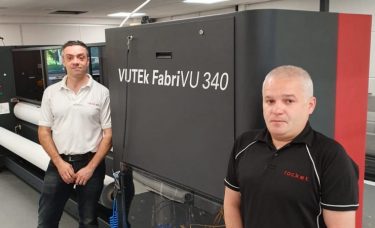
Rocket Graphics recently installed an EFI fabric printer
Design manager Nick Thomas was taken aback by the attention the company received in the wake of the episode airing. ‘It was as much a surprise to us that our design ended up in the limelight,’ he said. ‘The fabric was ordered through our web-to-print portal and it only really came to our attention when we saw the interest on social media after the first episode had aired.
‘We were delighted to see the print receive such a positive reaction, especially as the show is so synonymous with great costume design. The pyjama fabric is a perfect example of what can be achieved when great vision and design come together – it’s tremendously satisfying to see such an impactful end result.’
New horizons
The Killing Evestory demonstrates what all printers know, that print is everywhere, even if the general public isn’t always aware of it. From hit BBC dramas through to horse racing, print is all around us, but how many of the people who watched the recent contests at Cheltenham gave any thought to digital print’s role in producing the uniforms the jockeys were wearing?
Yet, in a world where sports teams are obsessed with marginal gains, and companies with their bottom lines, the benefits of digital print have seen all sorts of companies turn to print shops, or even invest in their own machinery. Take Racesafe, a manufacturer of equestrian silks in the UK and Europe, which recently installed a HP Stitch S300 dye sublimation printer.
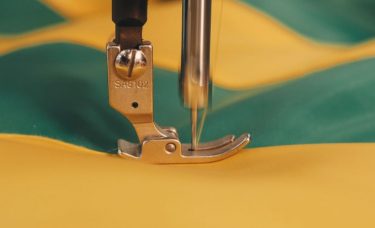
Racesafe opted for the HP Stitch as it needed a needed a printer that made accurate colour-matching faster and more straightforward
The Corby-based company manufactures one-off products for individual jockeys. Given the importance of weight in horse racing, and the customised nature of the clothing it produces, dye sublimation was a natural fit for Racesafe. The company first invested in a dye-sub printer several years ago, but upgraded to the 64-inch Stitch, which prints at 1200dpi, in order to better meet the demands of its customers.
‘Riders have their own designs and colours for their silks and, increasingly, also want branding and sponsors’ logos,’ director James How explained. ‘Matching registered shades on our old machine was fine for regularly produced colours but not for any new or unique designs – often it was done by hand. We needed a new printer that made accurate colour-matching faster and more straightforward.’
The S300, the smallest model in HP’s Stitch range, is opening up a raft of new possibilities for Racesafe. The machine is designed to achieve accurate colour matches predictably, quickly and simply. It can print on transfer paper and direct-to-fabric for maximum efficiency and versatility, while its front-loading design reduces the necessary floorspace. The Racesafe team has already run trials to produce custom clothing and accessories for golfers such as head covers and towels. They certainly won’t be stopping there.
This seems to be a theme for the HP Stitch – even for those with plenty of experience in dye-sub printing, and textiles more generally, it opens up new avenues. This was the case for Pixalili, a textile printing and design studio based on the Atlantic coast of Ireland. The company typically produces short-run or one-off lampshades, deckchairs, table linens and cushion covers, using either its own designs or those supplied by its customers.
Previously, the company was only able to offer products printed on natural fabrics such as linen, cotton and bamboo. But with demand growing for products such as velvet cushions, chiffon scarves and stretch jersey for baby clothes, the business decided to look into dye sublimation printing on polyester-based materials.
The team attended print industry events in Germany and the UK to explore the options for dye sublimation, finally choosing the HP Stitch S300 after seeing a demonstration at The Print Show in September 2019.
‘We are really in love with the Stitch,’ said research and development director James Harding. ‘We sent samples to valued customers to show them what we can now offer and the response has been fantastic.
‘Thanks to the HP Stitch we can become a one-stop-shop for existing customers and respond to demands from new buyers and markets. This is our first time using dye-sub and it opens up new avenues for us. We can see the Stitch being very, very busy.’
Fashion
Another place where short runs and personalisation are highly valued is, of course, the world of fashion. At the University of Westminster Epson’s SureColor machines are being used by budding designers to bring their creations to life.
As part of a plan to educate the fashion industry about on-demand dye-sublimation printing and its environmental benefits, Epson has provided the university with a new 24in SureColor SC-F500 printer, which will work alongside an existing 44in SC-F6200. Both are dye sublimation printers and will help students learn about the application of print within their designs.
‘I used print in my final collection to replicate the TV test cards of the late 1960s,’ said graduate Hannah Sosna. ‘Dye sublimation allowed me to print onto suiting fabric while still keeping the natural grain of the fabric.
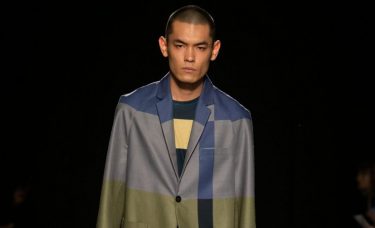
Students at the University of Westminster shows their designs at a fashion show
‘The prints in my collection are hand-painted using bold colours in big fluid brush strokes, however I wasn’t able to achieve the same effect on sheer fabrics such as polyester organza and silks. Print sublimation enabled me to transfer my hand-painting directly onto the fabric resulting in the same brushstroke achieved from direct hand painting.’
Retail
As its name suggests, Rocket Graphics produces wide-format digital print and signage. Last year the Watford-based business invested in an EFI Vutek FabriVu 340 dye sublimation printer in order to break into the retail sector.The company, which has won accounts with high street mainstay River Island and the cricket World Cup, installed the FabriVu textile printer at the beginning of May 2019, replacing an old Mtex inline sublimation printer.
The 3.4m printer prints at resolutions up to 2400dpi and can print directly onto textiles or onto transfer papers. It prints fabrics up to 180cm wide and between 45 and 450gsm. It operates at up to 400sqm/hr and EFI describes it as suitable for producing banners, flags, soft furnishings, soft signage and wall coverings.
‘Purchasing the FabriVu was a no-brainer, it’s a lot more reliable, and is opening up new areas for us,’ explained sales director Anthony Rider. ‘Investing in Vutek printers gives us colour consistency across the board, which is something we need especially when, with some jobs, we’re outputting 800 items on different materials, and all the colours have to be the same.’
The purchase is part of a £700,000 spree the company has gone on in recent months which has also seen it bring in an EFI Vutek LX3 LED printer, two Mimaki UCJV300-160 UV inkjet printers, a Klieverik calender and two Graphtec FC8600/160 vinyl cutters.
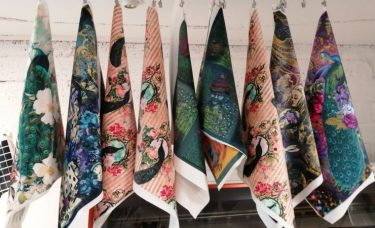
Irish company Pixalili produces one-of-a-kind products including scarves
Down to a T
Roland recently demonstrated its commitment to textile printing, introducing the Texart XT-640S DTG printer, in March of this year. The new press is designed for rapid printing of T-shirts via a jig that allows 12 garments to be printed at once, each with a different design.
However it is the Texart RT-640 that canoe and kayak specialist Peak UK installed when it became an official kit supplier of the 2016 Olympic Games. The Derbyshire-based company still uses its dye-sublimation transfer printer to produce sportswear for Olympic teams and professional athletes across the world.
Partnering with British Canoeing to become official supplier of the kit at the 2016 Olympics gave Peak UK the impetus to invest in textile printing technology. Previously producing prototypes by hand, the company needed a printer to be able to personalise its products in order to reflect Team GB’s branding.
‘We were instantly drawn to the Roland DG Texart RT-640 dye-sublimation transfer printer because it was more industrial and robust than its competitors, with the open design making it easier to service, clean and maintain,’ explained Peak UK founder, Peter Astles. ‘We quickly got to grips with the machine and one year later, we still cannot fault it. The machine is truly faultless, effortlessly printing high quality prints to the extent where we haven’t had one bad print.’
‘The RT-640 enabled us to quickly and easily print the unique and bespoke designs needed to cater for national teams and professional athletes; from national emblems to sponsors to patriotic colours,’ said Mr Astles. ‘You can literally create any look for scratch. And the best thing about the Roland DG machine is that it offers complete flexibility – we can print one or one hundred garments with the same ease.’
